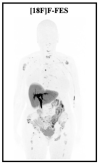Non-conventional and Investigational PET Radiotracers for Breast Cancer: A Systematic Review
- PMID: 35492341
- PMCID: PMC9039137
- DOI: 10.3389/fmed.2022.881551
Non-conventional and Investigational PET Radiotracers for Breast Cancer: A Systematic Review
Abstract
Breast cancer is one of the most common malignancies in women, with high morbidity and mortality rates. In breast cancer, the use of novel radiopharmaceuticals in nuclear medicine can improve the accuracy of diagnosis and staging, refine surveillance strategies and accuracy in choosing personalized treatment approaches, including radioligand therapy. Nuclear medicine thus shows great promise for improving the quality of life of breast cancer patients by allowing non-invasive assessment of the diverse and complex biological processes underlying the development of breast cancer and its evolution under therapy. This review aims to describe molecular probes currently in clinical use as well as those under investigation holding great promise for personalized medicine and precision oncology in breast cancer.
Keywords: FAPI; FES; FLT; PET; PSMA; breast cancer; molecular imaging; radiotracers.
Copyright © 2022 Balma, Liberini, Racca, Laudicella, Bauckneht, Buschiazzo, Nicolotti, Peano, Bianchi, Albano, Quartuccio, Abgral, Morbelli, D'Alessandria, Terreno, Huellner, Papaleo and Deandreis.
Conflict of interest statement
The authors declare that the research was conducted in the absence of any commercial or financial relationships that could be construed as a potential conflict of interest.
Figures





References
Publication types
LinkOut - more resources
Full Text Sources
Medical
Miscellaneous

